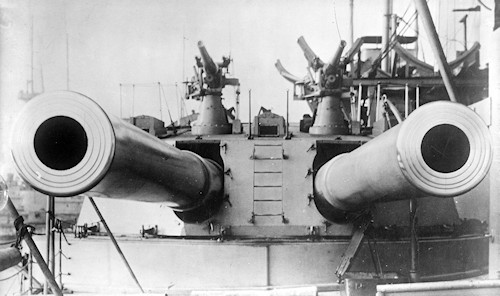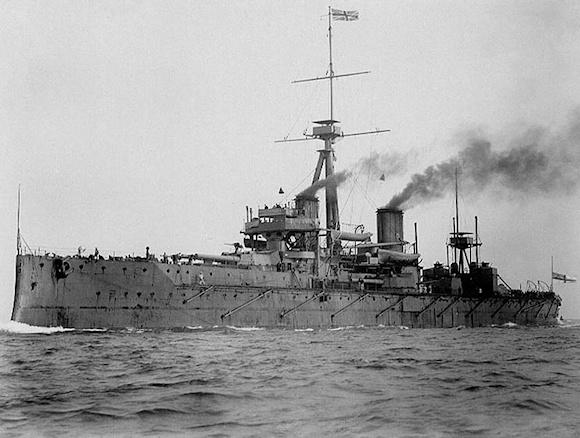Vittorio Emilio Cuniberti (1854-1913), naval engineer officer, developed the concept of the modern armored ship with thick armour, homogeneous battery of large caliber guns and high speed. His studies were expressed in the revolutionary British battleship HMS Dreadnought launched in 1906 (opening photo).
Among the numerous assignments and international recognitions we mention:
- in 1893, sent for several months to Germany as a consultant for the application on some ships of the German navy of the modifications necessary for the use of liquid fuel in the boilers (the invitation was made personally by the emperor, after publication, on the Maritime magazine of 1893, of articles on oil burning)
- in 1908, winner of the international competition announced in 1906 by the Imperial Russian Navy for the reconstruction of the fleet (his project was the first classified among the seventy-two received from all over the world). The four battleships class Gangut of 23.000 tons designed by Cuniberti (following photo), they constituted the cornerstone of the Russian fleet until the Second World War.
Between the end of the XNUMXth century and the beginning of the XNUMXth century, after the abandonment of the artillery on the bulwarks and their installation in armored swiveling towers, the custom of embarking on battleships, as the main armament, pieces of different caliber, complicating the problem of direction of fire and requiring several ammunition depots.
 Battleship designs of the time generally had four main guns in twin towers, aft and fore, with several smaller guns lined up along the sides of the ship, a similarity from sailing warships. Each caliber of gun had different ballistic properties, complicating aiming operations, especially the observation of impact spray.
Battleship designs of the time generally had four main guns in twin towers, aft and fore, with several smaller guns lined up along the sides of the ship, a similarity from sailing warships. Each caliber of gun had different ballistic properties, complicating aiming operations, especially the observation of impact spray.
In this period, the need arose to have new naval units, with a high and uniform firepower, so as to simplify ammunition and shooting. Naval planning moved both in Italy and in England - where as early as 1900 Admiral John Fischer (1841-1920), supported the idea of a fast and monocaliber battleship - with the concept of a warship armed only with cannons large caliber (all-big-gun) capable of shooting at great distances.
The Russo-Japanese War (1904-1905), provided the practical experience to prove its worth. The Russian Navy was defeated in naval battles, especially in the battle of Tsushima by the Imperial Japanese Navy, equipped with modern battleships, mostly of British design. The events of the battle confirmed to the world that in the naval battles of the time, only the largest calibers were important.
On an idea of Admiral Giovanni Bettolo (1846-1916), the colonel of the naval genius Vittorio Emanuele Cuniberti (1854-1913), in 1903, first posed the concept of a battleship armed only with large-caliber cannons , and designed two versions of battleship: one of 8.000 tons, eight guns and a speed of 22 knots, the other of 17.000 tons, twelve guns and equal speed.
Cuniberti designed numerous vessels including, in the early twentieth century, the class of battleships Vittorio Emanuele, considered by many to be the true forerunners ofbattle cruiser. He introduced oil burning in steam boilers, perfected the torpedo, improved the underwater defense of battleships, and unified the caliber of the main armament of battleships. He designed a type of battleship of modest displacement (8.000 tons), armed with 203 mm guns, which, with some modifications, was later adopted in the four ships of the class Regina Elena, from 12.700 tons, set by 1901.
When the Regia Marina, for economic reasons, did not pursue his idea, Cuniberti, having obtained his permission, wrote an article for "Jane's Fighting Ships", entitled "An ideal battleship for the British Navy", in which he proposed to the British Navy, a future battleship of 17.000 tons displacement, armed with a main gun of twelve 305 mm guns, equipped with an armored belt 30 cm thick and with a speed of 24 knots. The calculated speed was sufficient to outrun every battleship in existence.
The impression on insiders was enormous, and a debate began among naval experts from all over the world, a debate even more heated by the launch, in 1905, of the British battleship HMS Dreadnought. Thus began the season of monocaliber battleships that would accompany the battleship with subsequent technical improvements.
 Il project committee by Admiral John Fisher produced, in 1904, the design for the Dreadnought which was set up and assembled with unprecedented speed. The use of uniform main batteries greatly simplified fire correction in action. Given that all the guns had the same ballistic characteristics and that they were all controlled by a single firing station. Another innovation was the elimination of the longitudinal passages between the compartments below the main deck. The typical crew arrangement was reversed, enlisted personnel housed forward of the vessel and officers aft: unlike sailing vessels, which were controlled from the stern, modern warships were controlled from the top deck and in the first quarter , or third of the vessel. She was also the first vessel powered exclusively by steam turbines: 4 groups for a total of 24.700 hp. The engine unit, with the adoption of Parsons turbines*, had allowed - for the same power - a considerable saving in weight compared to the alternative drives of the previous battleships.
Il project committee by Admiral John Fisher produced, in 1904, the design for the Dreadnought which was set up and assembled with unprecedented speed. The use of uniform main batteries greatly simplified fire correction in action. Given that all the guns had the same ballistic characteristics and that they were all controlled by a single firing station. Another innovation was the elimination of the longitudinal passages between the compartments below the main deck. The typical crew arrangement was reversed, enlisted personnel housed forward of the vessel and officers aft: unlike sailing vessels, which were controlled from the stern, modern warships were controlled from the top deck and in the first quarter , or third of the vessel. She was also the first vessel powered exclusively by steam turbines: 4 groups for a total of 24.700 hp. The engine unit, with the adoption of Parsons turbines*, had allowed - for the same power - a considerable saving in weight compared to the alternative drives of the previous battleships.
Construction began in Portsmouth Dockyards between October 1905 and December 1906. She was launched by King Edward VII (1841-1910) on 10 February 1906, after only four months of work.
The HMS Dreadnought put to sea on October 3, 1906 after only one year and one day from the beginning of the construction. The process had been expedited by using the towers originally designed for the classroom Lord Nelson, battleships that had preceded her. The speed of the ship's construction was almost "alarming" to other navies.
The HMS Dreadnought commissioned for sea trials in December 1906. In January 1907 she sailed for the Mediterranean Sea and then to Trinidad. Upon her return to Portsmouth she became the flagship of the Home Fleet.

Later, 24 76 mm guns were added for close defense (pictured above the tower). A curious detail of the armament consisted in the presence, in addition to the 23 457 mm torpedoes for the embarked torpedo launchers, also of other six 356 mm, which should have been embarked by the steam boats on board, transformed into torpedo boats. Solution that was never practiced.
She was such a revolutionary ship that her name became a generic term for modern battleships, the previous ones being referred to as "pre-dreadnoughts".
Its introduction triggered an arms race between Great Britain and other navies around the globe. The Germans remained passive for the moment, this in order not to further stiffen the already tense relations with England, but in 1907 they set up their first monocalibre, the Classes Nassau, then the Heligoland, Konig, Kaiser, followed by the Baden e Bavaria with 8 cannons from 380 mm.
The United States began planning a full-caliber battleship before HMS Dreadnought. The USS South Carolina and the USS Michigan were presented at the Congress in the 1904, but were set only in the fall of 1906. The class South Carolina mounted all of its main cannons on the central line, avoiding the towers on the sides preferred by the British. They were equipped with triple expansion steam engines, not turbines, a conservative approach required by the US requirement of greater autonomy at speeds.
 Only in 1908, Italy decided to build such a unit. The study of the project was entrusted to the lieutenant general of the naval engineers Edoardo Masdea (1849-1910), who worked on a project of a ship weighing approximately 20.000 tons, well armoured, armed with 12 305 mm guns, and capable of a above 22 knots. In order to contain the weight of heavy artillery, the project led to the adoption, for the first time in the world, of large caliber triple turrets (photo).
Only in 1908, Italy decided to build such a unit. The study of the project was entrusted to the lieutenant general of the naval engineers Edoardo Masdea (1849-1910), who worked on a project of a ship weighing approximately 20.000 tons, well armoured, armed with 12 305 mm guns, and capable of a above 22 knots. In order to contain the weight of heavy artillery, the project led to the adoption, for the first time in the world, of large caliber triple turrets (photo).
The "Dante Alighieri", this was the name of the first Italian monocaliber unit, was laid down in June 1909 and entered service in 1913. The Dante Alighieri it was also the first Italian battleship equipped with 4 propellers, with a turbine engine apparatus and part of the boilers, with oil combustion.
At the outbreak of World War I, the Royal Navy had 19 battleships in service and 13 were under construction, Germany had 13 and 7 under construction. The other fleets equipped with battleships in 1914 were: United States (8), France (8), Japan (4), Austria-Hungary (2) and Italy (1).
* Charles Algernon Parsons (1854-1931) his name is linked to the construction of the first reaction steam turbine, which he patented in 1884, and which he produced in 1889, in his factories in Heaton. While the first Italian steam turbine was built and perfected, in 1905, by the engineer Giuseppe Belluzzo (1876-1952), later used on the battleships Cavour and about the class Littorio.
Photo. web












